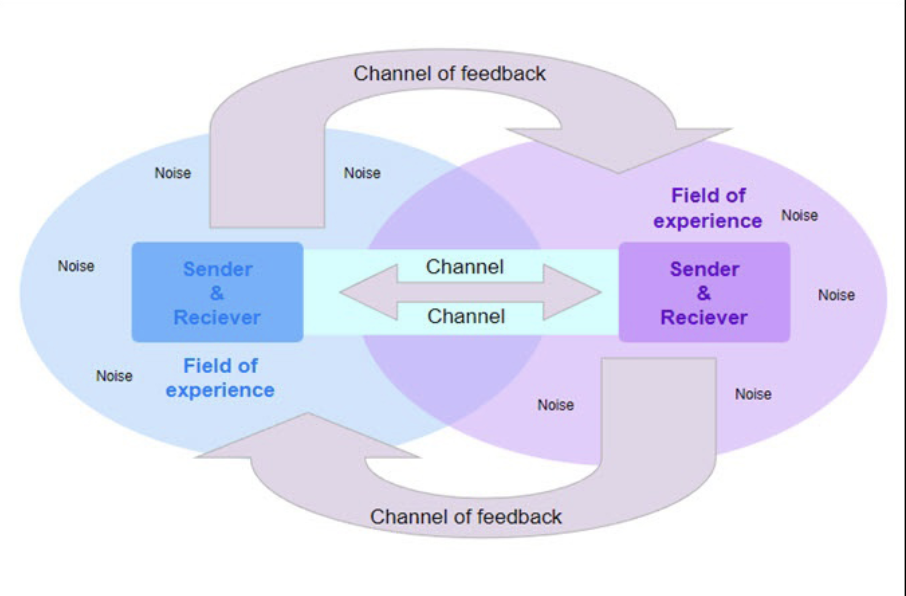PUBLIC SPEAKING UNIT 1
1/48
There's no tags or description
Looks like no tags are added yet.
Name | Mastery | Learn | Test | Matching | Spaced |
|---|
No study sessions yet.
49 Terms
Transactional model of communication

Frame of reference
Sum of knowledge, experience, etc to help how you view the world (Area around the communicator)
Communicator
Person communicating
Noise
Anything that disrupts, interrupts, or interferes with the communication process (Surrounding both communicators)
Channel
The means through which a message gets from sender to receiver (Surrounding the message)
Messaging
Words and language (Between the 2 communicators inside the channel)
Context
The environment where the communication or speech takes place
Encode
The process of the sender putting his/her thoughts and feelings into words or other symbols
Decode
The process of the listener or receiver understanding the words and symbols of a message and making meaning of them
Denotative
the objective or literal meaning shared by most people using the word
Connotative
the subjective or personal meaning the word evokes in people together or individually
Public speaking
an organized, face-to-face, prepared, intentional (purposeful) attempt to inform, entertain, or persuade a group of people (usually five or more) through words, physical delivery, and (at times) visual or audio aids.
Nonverbal messages
messages that are communicated without using words (body language, eye contact, gestures)
Verbal messages
a message that is conveyed through spoken or written words
Differences of public speaking and conversation
Awareness of and sensitivity toward your audience, an exchange of explicit messages about content (facts, ideas, information) and less explicit ones about relationships (how you relate to one another, such as trust, liking, respect), more purposeful (to entertain, inform, or persuade)
Similarities between public speaking and communication
A dependence on feedback to know if you are successful in being understood, nonverbal and verbal cues,
Reasons for speech anxiety
Mental blocks and forgetting the content, self depreciation, lack of preparation, fear of rejection of one’s self or one’s ideas.
Glossophobia
Severe fear of public speaking
Preparation to build speech confidence
Mental, physical, contextual, and speech preperation
5 classical canons of rhetoric.
1. invention (creating content),
2. disposition (organization and logic of arguments)
3. style (choosing the right level and quality of vocabulary)
4. memory (actually, memorizing famous speeches to learn good public speaking technique)
5. delivery (nonverbal communication).
Invention
Creating content
Disposition
Organization and logic of arguments
Style
choosing the right level and quality of vocabulary
Memory
Actually, memorizing famous speeches to learn good public speaking technique
Delivery
The nonverbal communication
Exigence
Problem waiting to be fixed, reveals speech purpose (driving force)
Audience
Anybody exposed to the speech
Constraints
Physical and psychological parts that create limits on things like success
Empirical audience
The people that the speaker faces and interacts directly with
Target audience
The members of an audience the speaker most wants to persuade and who are likely to be receptive to persuasive messages
3 physical constraints
Time limits, space to give speech, giving all parts of the speech
Audience analysis
Examining and looking at your audience first by its demographic characteristics and then by their internal psychological traits
Demographic characteristics
the outward characteristics of the audience
Demographic characteristics examples
Age, race, gender, education level, ethnicity, income, occupation, marital status
Beliefs
Statements we hold to be true
Attitudes
A stable positive or negative response to a person, idea, object, or policy
Values
Goals we strive for and what we consider important and desirable
Needs
Important deficiencies that we are motivated to fulfill
Barries faced by audiences
Noisiness/distraction in our outside lives, keeping attention, our minds can usually process much faster than a speaker can speak clearly, distraction around you.
4 ways to become a better listener
Be prepared to listen, take notes/ask questions, avoid temptations, have an open mind to the speaker
Ethics
the branch of philosophy that involves determinations of what is right and moral
Factors that influence trust in a speaker
Similarity, character, competence, and good will
Initial credibility
A speaker’s credibility at the beginning of or even before the speech
Derived credibility
a speaker’s credibility and trustworthiness (as judged by the audience members) throughout the process of the speech, which also can range from point to point in the speech
Terminal credibility
a speaker’s credibility at the end of the speech
Plagiarism
the act of using another person’s words or ideas without giving credit to that person
Stealing
to steal and pass off (the ideas or words of another) as one's own
Borrowing
taking ones ideas and citing them incorrectly or not at all
Sneaking
Copying a few words and twisting them to seem like they were your own